Cyperus are tall aquatic grasses native to tropical and south tropical regions characterized by large terminal inflorescences that give a particular parasol-like appearance (or umbrella as the English say). This genus includes 600 species of little economic value but some are sought after as ornaments for water features. In Thailand 47 species have been listed and about as many in Laos where mak heo and mak heo mou (respectively C. esculentus and C. rotondus) are mainly known.
Two other species are cultivated here in the gardens and first of all the famous papyrus of the Egyptians: Cyperus papyrus, tone pheu in Lao. Native to central and tropical Africa, it was introduced very early in Egypt and southern Europe; it is still found wild in Sicily and cultivated in many gardens. In papyrus as in many other species of the genus the leaves are very reduced and it is bracts having the appearance of leaves which are the head of the plant; they form a thin, long and hanging tuft. The flowers above this tuft constitute large umbels with a hundred or more rays ending in small spikes or spikelets.
The pith of the stems provided the material for the writing support called papyrus. This paper was manufactured for 3 millennia from 2500 BC to the 11th century AD. The word “papyrus” comes from Latin, borrowed from the Greek papyros with an unclear etymology but this term is most certainly at the origin of the english and french word “paper”. Papyrus stems were also used to make basketwork and boats. The Norwegian Thor Heyerdahl proved in 1970 that one could leave North Africa and arrive in America on a boat made of Papyrus like those of the ancient Egyptians.
Another species, Cyperus involucratus, sèma or hangka in Lao is often planted as decoration in gardens. The leaf-shaped bracts are wider and less numerous than in papyrus; they are arranged alternately around the terminal stem; the spikelets are grouped near the center and the plant forms a dense tuft of a fairly dark green that can be 2 meters high. Many other Cyperus are found in the wild in Laos, we can cite:
Cyperus procerus: pheu, quite close to Papyrus,
Cyperus diffusus: pheu dong, hang ka
Cyperus leucocephalus: houa ngok, nouat pa douk
All have been used or are still used to make mats or coarse basketwork from the frayed and woven stems. The rhizomes of some, macerated in water, are considered a refreshing medicine (ya dièn) for children.
Les Cyperus sont de hautes herbes aquatiques originaires des régions tropicales et sud tropicales caractérisées par de grandes inflorescences terminales qui donnent une allure particulière en ombrelle (ou en parapluie comme disent les Anglais). Ce genre compte 600 espèces de peu de valeur économique mais certaines sont recherchées comme ornements des pièces d’eau. En Thaïlande on a répertorié 47 espèces et à peu près autant au Laos où l’on connaît surtout mak hèo et mak hèo mou (respectivement C. esculentus et C. rotondus).
Deux autres espèces sont cultivées ici dans les jardins et en premier lieu le célèbre papyrus des Egyptiens: Cyperus papyrus, tone pheu en lao. Originaire d’Afrique centrale et tropicale, il a été introduit très tôt en Egypte et en Europe du Sud; on le trouve encore sauvage en Sicile et cultivé dans de nombreux jardins.
Dans le papyrus comme dans de nombreuses autres espèces du genre les feuilles sont très réduites et ce sont des bractées ayant l’apparence de feuilles qui sont la tête de la plante; elles forment une houppe fine, longue et pendante. Les fleurs au–dessus de cette houppe constituent de grandes ombelles à cent rayons ou plus terminés par des petits épis ou épillets.
La moelle des tiges fournissait le matériau pour le support d’écriture nommé papyrus. Ce papier a été fabriqué pendant 3 millénaires de 2500 ans AVJC jusqu’au XIème siècle APJC. Le mot « papyrus » vient du latin, emprunté au grec papyros à l’étymologie non élucidée mais ce terme est très certainement à l’origine du mot français « papier ». Les tiges de papyrus servaient en outre à la fabrication d’ouvrages en vannerie et de bateaux. Le Norvégien Thor Heyerdahl prouva en 1970 que l’on pouvait partir d’Afrique du Nord et arriver en Amérique sur un bateau fait de papyrus comme ceux des Egyptiens anciens.
Une autre espèce, Cyperus involucratus, sèma ou hangka en lao est souvent plantée comme décoration dans les jardins. Les bractées en forme de feuilles sont plus larges et moins nombreuses que dans le papyrus; elles sont disposées alternativement autour de la tige terminale; les épillets sont regroupés près du centre et la plante forme une touffe dense d’un vert assez foncé qui peut avoir 2 mètres de haut.
De très nombreux autres Cyperus se rencontrent à l’état sauvage au Laos, on peut citer:
Cyperus procerus: pheu, assez proche du papyrus,
Cyperus diffusus: pheu dong, hang ka
Cyperus leucocephalus: houa ngok, nouat pa douk
Tous ont servis ou servent encore à faire des nattes ou des vanneries grossières à partir des tiges effilochées et tissées. Les rhizomes de certains, macérés dans l’eau, sont considérés comme médicament rafraîchissant (ya dièn) pour les enfants.
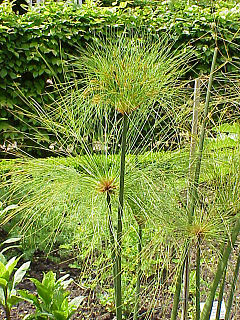
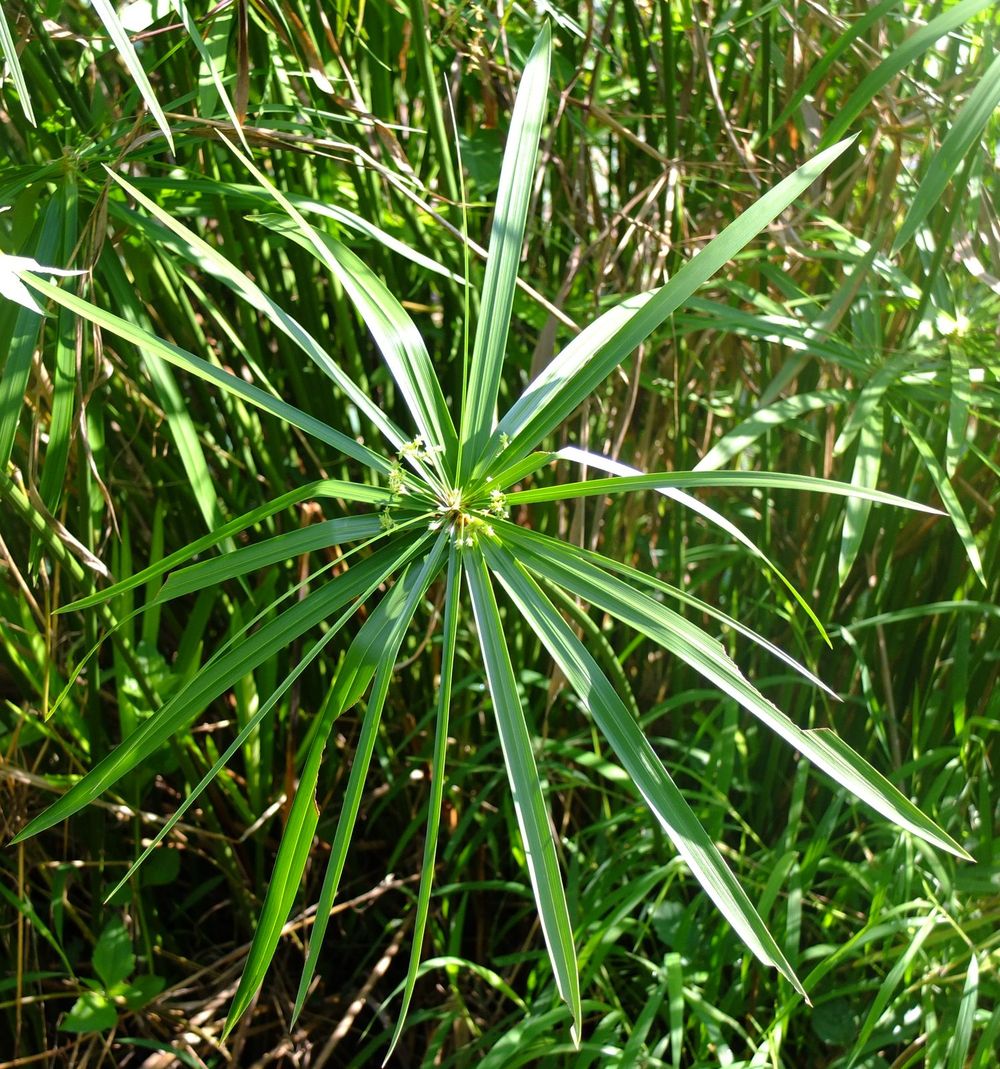
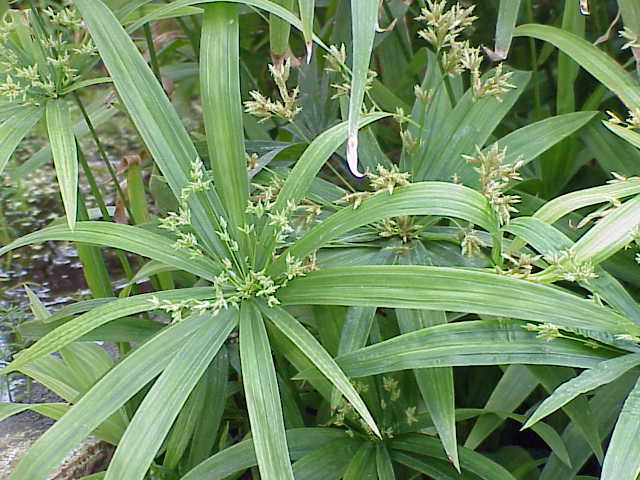
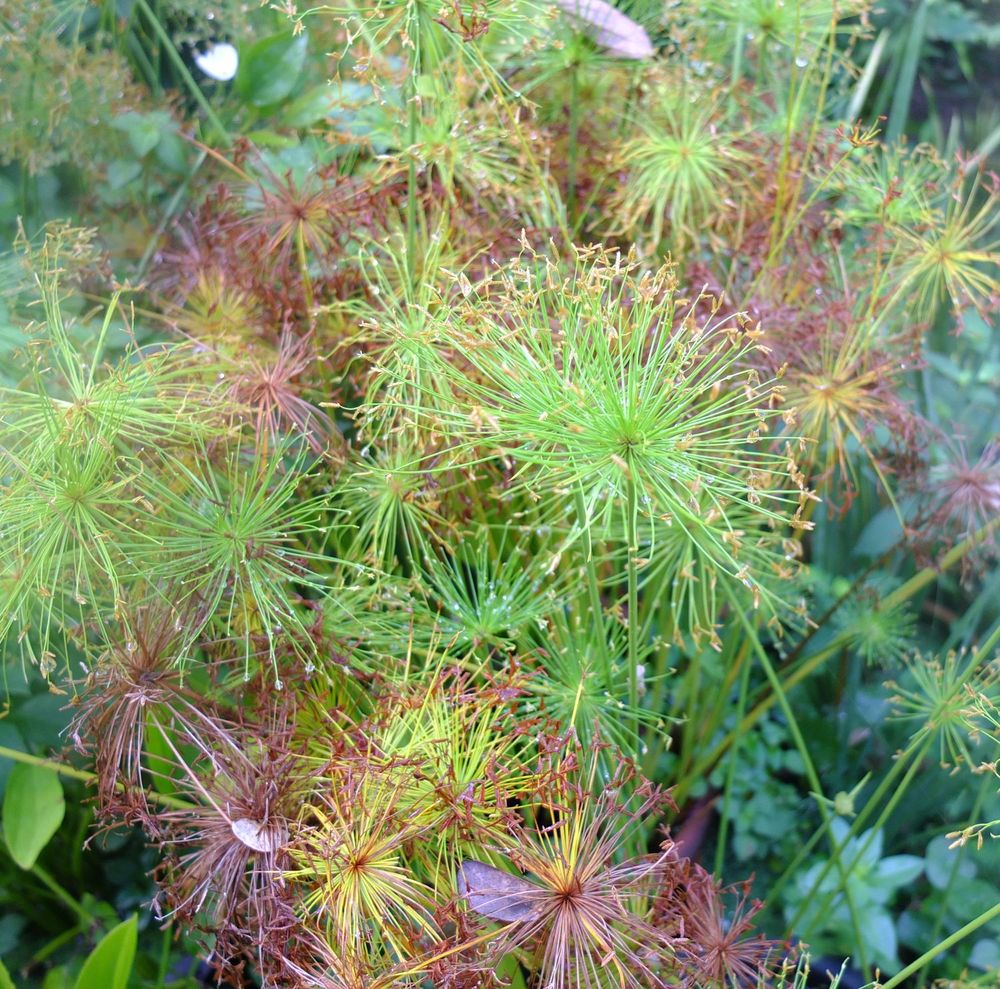
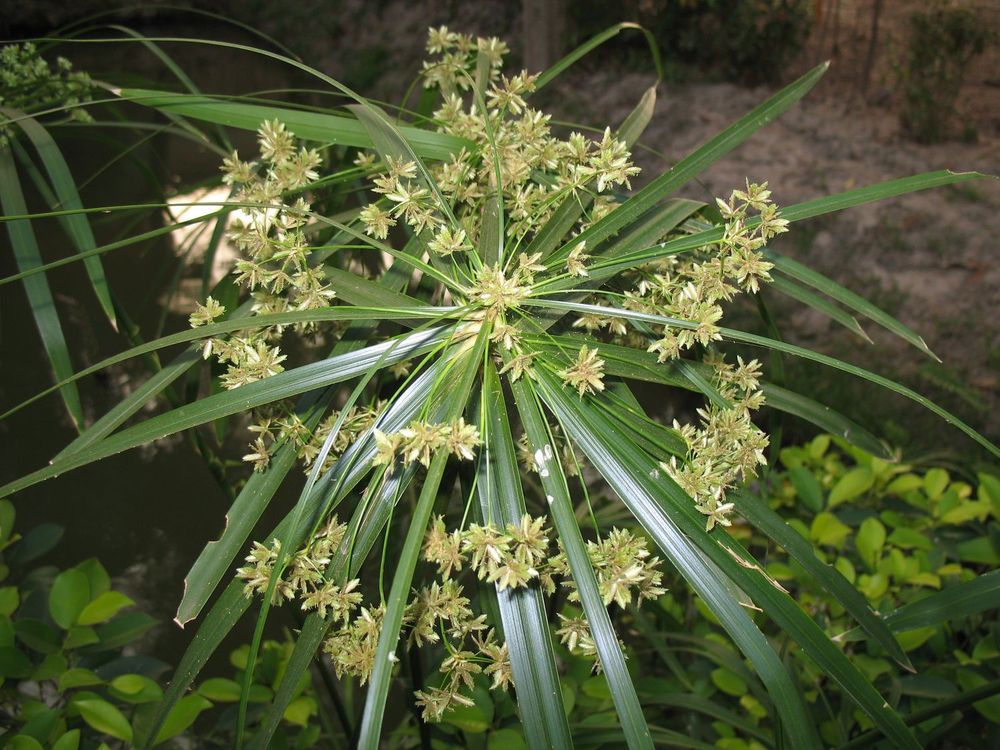
Cyperus are tall aquatic grasses native to tropical and south tropical regions characterized by large terminal inflorescences that give a particular parasol-like appearance (or umbrella as the English say). This genus includes 600 species of little economic value but some are sought after as ornaments for water features. In Thailand 47 species have been listed and about as many in Laos where mak heo and mak heo mou (respectively C. esculentus and C. rotondus) are mainly known.
Two other species are cultivated here in the gardens and first of all the famous papyrus of the Egyptians: Cyperus papyrus, tone pheu in Lao. Native to central and tropical Africa, it was introduced very early in Egypt and southern Europe; it is still found wild in Sicily and cultivated in many gardens. In papyrus as in many other species of the genus the leaves are very reduced and it is bracts having the appearance of leaves which are the head of the plant; they form a thin, long and hanging tuft. The flowers above this tuft constitute large umbels with a hundred or more rays ending in small spikes or spikelets.
The pith of the stems provided the material for the writing support called papyrus. This paper was manufactured for 3 millennia from 2500 BC to the 11th century AD. The word “papyrus” comes from Latin, borrowed from the Greek papyros with an unclear etymology but this term is most certainly at the origin of the english and french word “paper”. Papyrus stems were also used to make basketwork and boats. The Norwegian Thor Heyerdahl proved in 1970 that one could leave North Africa and arrive in America on a boat made of Papyrus like those of the ancient Egyptians.
Another species, Cyperus involucratus, sèma or hangka in Lao is often planted as decoration in gardens. The leaf-shaped bracts are wider and less numerous than in papyrus; they are arranged alternately around the terminal stem; the spikelets are grouped near the center and the plant forms a dense tuft of a fairly dark green that can be 2 meters high. Many other Cyperus are found in the wild in Laos, we can cite:
Cyperus procerus: pheu, quite close to Papyrus,
Cyperus diffusus: pheu dong, hang ka
Cyperus leucocephalus: houa ngok, nouat pa douk
All have been used or are still used to make mats or coarse basketwork from the frayed and woven stems. The rhizomes of some, macerated in water, are considered a refreshing medicine (ya dièn) for children.
Les Cyperus sont de hautes herbes aquatiques originaires des régions tropicales et sud tropicales caractérisées par de grandes inflorescences terminales qui donnent une allure particulière en ombrelle (ou en parapluie comme disent les Anglais). Ce genre compte 600 espèces de peu de valeur économique mais certaines sont recherchées comme ornements des pièces d’eau. En Thaïlande on a répertorié 47 espèces et à peu près autant au Laos où l’on connaît surtout mak hèo et mak hèo mou (respectivement C. esculentus et C. rotondus).
Deux autres espèces sont cultivées ici dans les jardins et en premier lieu le célèbre papyrus des Egyptiens: Cyperus papyrus, tone pheu en lao. Originaire d’Afrique centrale et tropicale, il a été introduit très tôt en Egypte et en Europe du Sud; on le trouve encore sauvage en Sicile et cultivé dans de nombreux jardins.
Dans le papyrus comme dans de nombreuses autres espèces du genre les feuilles sont très réduites et ce sont des bractées ayant l’apparence de feuilles qui sont la tête de la plante; elles forment une houppe fine, longue et pendante. Les fleurs au–dessus de cette houppe constituent de grandes ombelles à cent rayons ou plus terminés par des petits épis ou épillets.
La moelle des tiges fournissait le matériau pour le support d’écriture nommé papyrus. Ce papier a été fabriqué pendant 3 millénaires de 2500 ans AVJC jusqu’au XIème siècle APJC. Le mot « papyrus » vient du latin, emprunté au grec papyros à l’étymologie non élucidée mais ce terme est très certainement à l’origine du mot français « papier ». Les tiges de papyrus servaient en outre à la fabrication d’ouvrages en vannerie et de bateaux. Le Norvégien Thor Heyerdahl prouva en 1970 que l’on pouvait partir d’Afrique du Nord et arriver en Amérique sur un bateau fait de papyrus comme ceux des Egyptiens anciens.
Une autre espèce, Cyperus involucratus, sèma ou hangka en lao est souvent plantée comme décoration dans les jardins. Les bractées en forme de feuilles sont plus larges et moins nombreuses que dans le papyrus; elles sont disposées alternativement autour de la tige terminale; les épillets sont regroupés près du centre et la plante forme une touffe dense d’un vert assez foncé qui peut avoir 2 mètres de haut.
De très nombreux autres Cyperus se rencontrent à l’état sauvage au Laos, on peut citer:
Cyperus procerus: pheu, assez proche du papyrus,
Cyperus diffusus: pheu dong, hang ka
Cyperus leucocephalus: houa ngok, nouat pa douk
Tous ont servis ou servent encore à faire des nattes ou des vanneries grossières à partir des tiges effilochées et tissées. Les rhizomes de certains, macérés dans l’eau, sont considérés comme médicament rafraîchissant (ya dièn) pour les enfants.










Cyperus are tall aquatic grasses native to tropical and south tropical regions characterized by large terminal inflorescences that give a particular parasol-like appearance (or umbrella as the English say). This genus includes 600 species of little economic value but some are sought after as ornaments for water features. In Thailand 47 species have been listed and about as many in Laos where mak heo and mak heo mou (respectively C. esculentus and C. rotondus) are mainly known.
Two other species are cultivated here in the gardens and first of all the famous papyrus of the Egyptians: Cyperus papyrus, tone pheu in Lao. Native to central and tropical Africa, it was introduced very early in Egypt and southern Europe; it is still found wild in Sicily and cultivated in many gardens. In papyrus as in many other species of the genus the leaves are very reduced and it is bracts having the appearance of leaves which are the head of the plant; they form a thin, long and hanging tuft. The flowers above this tuft constitute large umbels with a hundred or more rays ending in small spikes or spikelets.
The pith of the stems provided the material for the writing support called papyrus. This paper was manufactured for 3 millennia from 2500 BC to the 11th century AD. The word “papyrus” comes from Latin, borrowed from the Greek papyros with an unclear etymology but this term is most certainly at the origin of the english and french word “paper”. Papyrus stems were also used to make basketwork and boats. The Norwegian Thor Heyerdahl proved in 1970 that one could leave North Africa and arrive in America on a boat made of Papyrus like those of the ancient Egyptians.
Another species, Cyperus involucratus, sèma or hangka in Lao is often planted as decoration in gardens. The leaf-shaped bracts are wider and less numerous than in papyrus; they are arranged alternately around the terminal stem; the spikelets are grouped near the center and the plant forms a dense tuft of a fairly dark green that can be 2 meters high. Many other Cyperus are found in the wild in Laos, we can cite:
Cyperus procerus: pheu, quite close to Papyrus,
Cyperus diffusus: pheu dong, hang ka
Cyperus leucocephalus: houa ngok, nouat pa douk
All have been used or are still used to make mats or coarse basketwork from the frayed and woven stems. The rhizomes of some, macerated in water, are considered a refreshing medicine (ya dièn) for children.
Les Cyperus sont de hautes herbes aquatiques originaires des régions tropicales et sud tropicales caractérisées par de grandes inflorescences terminales qui donnent une allure particulière en ombrelle (ou en parapluie comme disent les Anglais). Ce genre compte 600 espèces de peu de valeur économique mais certaines sont recherchées comme ornements des pièces d’eau. En Thaïlande on a répertorié 47 espèces et à peu près autant au Laos où l’on connaît surtout mak hèo et mak hèo mou (respectivement C. esculentus et C. rotondus).
Deux autres espèces sont cultivées ici dans les jardins et en premier lieu le célèbre papyrus des Egyptiens: Cyperus papyrus, tone pheu en lao. Originaire d’Afrique centrale et tropicale, il a été introduit très tôt en Egypte et en Europe du Sud; on le trouve encore sauvage en Sicile et cultivé dans de nombreux jardins.
Dans le papyrus comme dans de nombreuses autres espèces du genre les feuilles sont très réduites et ce sont des bractées ayant l’apparence de feuilles qui sont la tête de la plante; elles forment une houppe fine, longue et pendante. Les fleurs au–dessus de cette houppe constituent de grandes ombelles à cent rayons ou plus terminés par des petits épis ou épillets.
La moelle des tiges fournissait le matériau pour le support d’écriture nommé papyrus. Ce papier a été fabriqué pendant 3 millénaires de 2500 ans AVJC jusqu’au XIème siècle APJC. Le mot « papyrus » vient du latin, emprunté au grec papyros à l’étymologie non élucidée mais ce terme est très certainement à l’origine du mot français « papier ». Les tiges de papyrus servaient en outre à la fabrication d’ouvrages en vannerie et de bateaux. Le Norvégien Thor Heyerdahl prouva en 1970 que l’on pouvait partir d’Afrique du Nord et arriver en Amérique sur un bateau fait de papyrus comme ceux des Egyptiens anciens.
Une autre espèce, Cyperus involucratus, sèma ou hangka en lao est souvent plantée comme décoration dans les jardins. Les bractées en forme de feuilles sont plus larges et moins nombreuses que dans le papyrus; elles sont disposées alternativement autour de la tige terminale; les épillets sont regroupés près du centre et la plante forme une touffe dense d’un vert assez foncé qui peut avoir 2 mètres de haut.
De très nombreux autres Cyperus se rencontrent à l’état sauvage au Laos, on peut citer:
Cyperus procerus: pheu, assez proche du papyrus,
Cyperus diffusus: pheu dong, hang ka
Cyperus leucocephalus: houa ngok, nouat pa douk
Tous ont servis ou servent encore à faire des nattes ou des vanneries grossières à partir des tiges effilochées et tissées. Les rhizomes de certains, macérés dans l’eau, sont considérés comme médicament rafraîchissant (ya dièn) pour les enfants.


